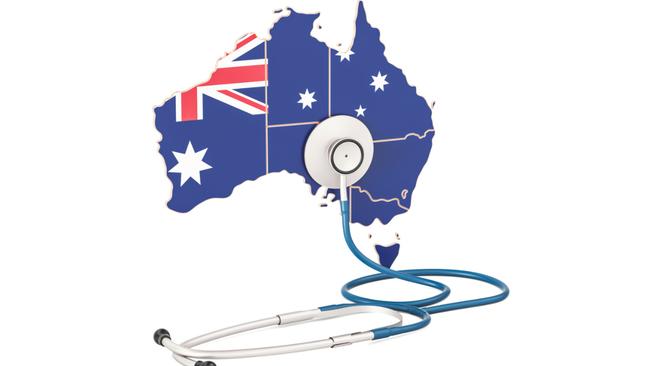Australia’s medical manufacturing sector – a global success story in the making
Australia is poised to become a health and medical products manufacturing powerhouse, according to government and industry leaders.

An opportunity for Australia exists to be global leader in health, pharmaceuticals and medical products
Federal government releases RNA Blueprint building on Medical Science Co-Investment Plan
Orthocell emphasises health and life sciences manufacturing is an area in which Australia excels
This is the first of a three-part special delving into the significant growth of Australia's health and medical manufacturing industry and its current and future opportunities.
Australia is on its way to becoming a global force in the manufacturing of health and medical products, believe government and sector leaders, with the wind "blowing in the right direction".
As part of the $15bn National Reconstruction Fund Corporation, established by the federal government, $1.5bn is targeted toward medical manufacturing as a priority area to "promote innovation in the industry and secure Australia’s sovereign capabilities in medical science".
In addition, the federal government has the $22bn Medical Research Future Fund, which is targeted to transform health, support medical research and grow Australia's medical manufacturing sector.
The blueprint builds on the government's Medical Science Co-investment Plan, which outlined investment target areas for both government and industry across a range of sectors including digital health, medical devices and innovative therapeutics.
Furthermore, the federal government last week released the industry-led Australia’s RNA Blueprint, and identified high-value, innovative complex therapeutics such as RNA vaccines as an area with strong economic potential for Australia.
The RNA sector is estimated to add up to $8bn to Australia’s GDP over the next 10 years with the blueprint backing Australia’s medical industry capability to make more medical products.
Lessons learned from Covid-19 pandemic
Federal minister for industry and science Ed Husic says the federal government recognises lessons learned from medical supply chain disruptions during the Covid-19 pandemic, with the need to build and develop more items in Australia.
“We’re backing a strong medical manufacturing sector because making more things here means creating more jobs," he says.
“Our nation’s health and medical research is already ranked seventh in the world and we’re ensuring our RNA sector continues to have the right settings in place, growing Australia’s manufacturing capability and positioning us as a ‘go to’ regional partner.”
Federal minister for health and aged care Mark Butler says Australia has some of the best medical researchers in the world.
“We need to utilise our talented medical researchers and grow a medical manufacturing industry that will be world leading, keeping more of our investment and development in Australia," he says.
“This is all part of the Albanese government working to deliver a future made in Australia.”
Australia's manufacturing backstory
Australia has a long and complex history with manufacturing dating back to Federation in 1901. When all the states and territories joined together opening trade, Australia's manufacturing industry started to grow.
Manufacturing was further boosted during World War I, reducing Australia’s reliance on importing goods from Europe, which had become increasingly difficult during the conflict.
By the mid-1920s, major American car manufacturers Ford and General Motors had set up factories in Australia to assemble their vehicles using imported components, calculating it was more cost-effective to build their cars locally than to import them fully assembled.
The Great Depression hit from the late 1920s to late 1930s causing an economic downturn affecting many industries with the federal government applying tariffs to many imported goods in a bid to make them more expensive and encourage the purchase and production of locally produced goods, which were not subject to a tariff.
Heading into World War II and up until the 1960s, Australia's manufacturing continued to grow, fuelled by several factors including an increase in migration bringing more skilled workers to the country and a growth in household prosperity, meaning more money to spend.
But by the 1960s and 1970s, while Australia was doing well with manufacturing, other countries were also advancing and globalisation was starting to have an impact. Australia's trade relationship with Britain was reducing and the country started looking to other markets, particularly Asia, for trade relationships.
Furthermore, Australia started entering more free trade agreements and reducing or even eliminating tariffs on imported goods, subsequently increasing competition.
For the motor vehicle industry this meant more cars from Asia and Europe and the demise of locally produced vehicles in Australia by the mid 2010s.
In the 1950s and 1960s more than 25% of Aussie jobs were in manufacturing, which has dropped substantially in the decades since to today stand at only 6.3%.
But moves are now underway to revitalise Australia's manufacturing capability.
Case in point, there's the National Reconstruction Fund and Future Made In Australia (FMIA) program, which will see $22.7 billion invested by the federal government over the next decade towards advanced manufacturing and clean energy projects within Australia as the world moves to net zero.
And then, there is the compelling area of health and medical life sciences manufacturing…
A strong history of medical manufacturing
Former COO and CEO of Ausbiotech (Australia's biotechnology organisation) and EZZ Life Science (ASX:EZZ) chairman Glenn Cross has more than 40 years’ experience in the life science sector domestically and internationally.
Cross told Stockhead Australia has a long and proud history of medical and pharmaceutical manufacturing. He has always believed Australia could particularly be one of the great medical manufacturing countries of the world.
"One of the first wireless manufacturing plants outside of Italy was in Sydney," he says.
In 1909, German company Telefunken established a subsidiary in Sydney to promote a novel tech known as radio and around four years later the subsidiary merged with the Australian branch of the British-based Marconi company, resulting in the creation of Amalgamated Wireless (Australasia) Ltd, commonly known as AWA.
"They manufactured Australia's first TV sets and out of that technology the first pacemakers were manufactured in Australia by a company called Telectronics," he says.
"Some of the first X-ray machines in the world were manufactured out of Sydney by a company called Watson Victor back in the 1940s and 1950s."
Cross says wireless technology advances in Australia helped propel manufacturing of products for hearing specialist Cochlear (ASX:COH) and leader in obstructive sleep apnoea (OSA) and other sleep-related respiratory disorders ResMed (ASX:RMD).
He says several global pharmaceutical companies established manufacturing facilities in Sydney, such as Johnson & Johnson, Novatis, and Merck, while Glaxo Smith Kline (GSK) set up manufacturing in Melbourne. However, most have now largely taken their manufacturing into Asia.
He says Melbourne's medical manufacturing is predominantly with the biggest company on the ASX health care index, CSL (ASX:CSL), which was founded in 1916 as Commonwealth Serum Laboratories, an Australian government body to service the needs of Australia isolated by war. CSL was incorporated in 1991 and listed on the ASX in 1994.
"Melbourne has been the biotech centre although there hasn't had a lot of manufacturing but there is now with mRNA and some of the cellular therapy manufacturing being set up," Cross says.
He notes that other locations of Australia also have been involved in manufacturing including Brisbane, with DSM Biologics operating Australia's first major contract manufacturing facility for biologic drugs and therapeutics after receiving a grant from the federal government and seed funding from the Queensland government in 2010. DSM later merged with Patheon, which was then taken over by Thermo Fisher Scientific.
"What does the future hold? well we now have mRNA manufacturing in Sydney, Melbourne and Brisbane and cellular therapies is a big opportunity for us."
"There are also a number of small medtechs manufacturing in Australia and you can do it as scale because it's small volume, high value so you don't need cheap labour and Australian labour is not really expensive anyway any more.
"We don't want to manufacture bandages and simple devices, but more complex devices and the capability exists but we just need people to realise we can do that in Australia rather than going somewhere in Asia."
'Wind is blowing in the right direction'
Orthocell (ASX:OCC) managing director Paul Anderson told Stockhead Australia has an opportunity to become a leader in the production of health and medical life sciences products.
OCC is focused on advancing tissue regeneration and repair with its manufacturing facility based at its headquarters on the grounds of Murdoch University in Perth.
"All the wind is blowing in the right direction, and we also have, from a geopolitical perspective, a lot of concerns about our sovereign risk and manufacturing out of China," he says.
"The US FDA recently provided guidance that basically says you have to be very careful if you're getting any data or raw materials from China because there have been questions about quality."
Anderson says while India was also sprouted as a potential manufacturing hub for pharmaceuticals there have been growing concerns about quality impacting product quality and patient care.
"People are questioning the reliance of the quality coming out of China and India" he says.
"We have large amounts of potential money from the feds, large amounts of potential money from the states, geopolitical change, excellence in manufacturing and excellence in pre-clinical and clinical studies which can be done in this country.
"What we're probably not as good at doing is the larger Phase 2 and Phase 3 studies because we don't have enough patients, but we are very good at manufacturing products and Phase 1 studies because they're cost effective in Australia and you don't need large amounts of patients."
Multinational interest
Anderson says international companies are recognising the opportunities for health and medical manufacturing in Australia with, as an example, Bridgewest Group – a large US multinational private equity outfit focused on software, tech and life sciences.
Established by brothers Dr Massih Tayebi and Dr Masood Tayebi, Anderson says Bridgewest has now invested in more than 80 companies in life sciences, including in Australia.
In November 2023, Bridgewest Group announced it was purchasing from Pfizer its sterile injectable manufacturing facility in Perth, which has a strong regulatory history with approvals from FDA, TGA, EU and others.
Bridgewest Perth Pharma, a subsidiary of Bridgewest Group, now operates NovaCina, a contract development and manufacturing organisation (CDMO) specialising in sterile injectables, and LumaCina, a global supplier of high quality sterile injectable pharmaceutical products.
"We have large multinational American group Bridgewest saying we want to be here because we think the conditions are right for Australia to proliferate manufacturing and deliver products internationally," Anderson says.
In 2020, Bridgewest also acquired Hospira Adelaide Pty Ltd, a microbial drug substance manufacturer in Adelaide, which it now operates under the name BioCina.
"Australia has an active and forward-thinking medical science community with outstanding universities, advanced research, and clinical trial capabilities," co-founder and CEO of Bridgewest Group Dr Masood Tayeb said when the company announced the purchase of the Perth Pfizer facility.
"Further, the Australian government has been extremely proactive in providing incentives to attract pharmaceutical manufacturing investment in the country.
"Leveraging our experience and resources, we are confident that we can continue to build upon Australia's reputation as a global leader in pharmaceutical manufacturing."
At Stockhead, we tell it like it is. While EZZ Life Sciences and Orthocell are Stockhead advertisers, the companies did not sponsor this article.


